



QUBIT AI: Banz & Bowinkel
Bots
FILE 2024 | Installations
International Electronic Language Festival
Bots presents a computer-controlled society through a series of algorithmically controlled humanoid avatars that appear on physical carpets using augmented reality (AR). Real-time performances synthesize human behavioral patterns into a formalized digital social study. Omnipresent, combined with our devices and incorporated into virtual environments, the work reminds us of our own digitalized world, in which we are surrounded by invisible bots.
Bio
Giulia Bowinkel (born 1983) and Friedemann Banz (born 1980) live in Berlin and have worked together under the name Banz & Bowinkel since 2009. In 2007 they graduated from the Art Academy with Albert Oehlen and started making art with computers . His work encompasses computer-generated imagery, animation, augmented reality, virtual realities and installations.
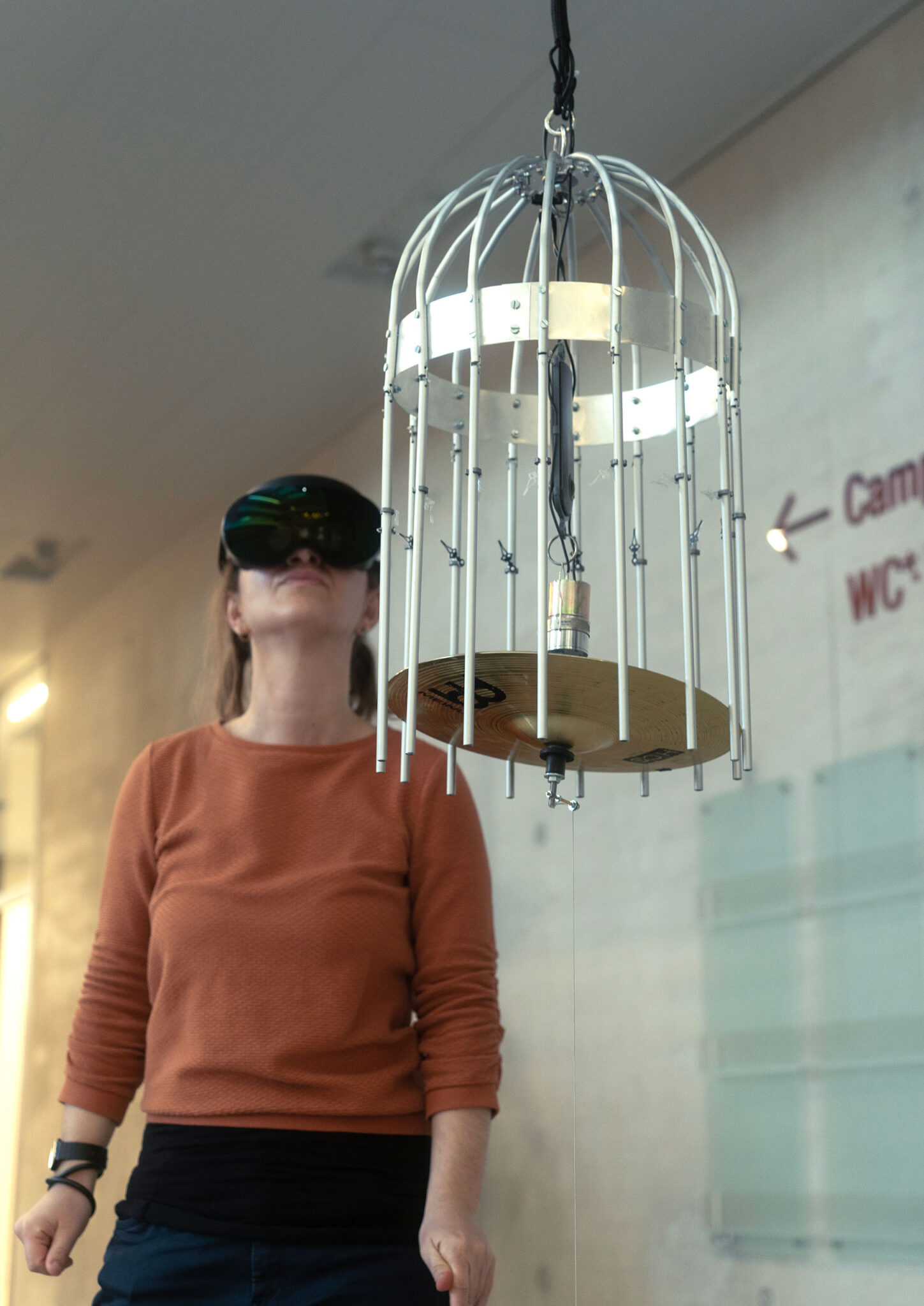
QUBIT AI: Anna Vasof & VRinMotion Team
The Cage of Time
FILE 2024 | Installations
International Electronic Language Festival
Interactive installation that presents a kinetic instrument object and virtual reality glasses, functioning as a device that animates the illusion of the passage of time in virtual space. In the fabric of existence, time weaves a cage around our ephemeral moments, limiting our perceptions of the past, present and future. By embracing this paradox, we may discover that the cage of time becomes the crucible where the alchemy of experience transforms our understanding of existence.
Bio
Anna Vasof is a multi-award-winning artist who focuses on filmmaking, short videos, and time-based sculptures. VRinMotion is an artistic research project based at St. Pölten University of Applied Sciences in Austria that investigates how features of stop-motion animation and motion capture can be combined with virtual reality to enrich current artistic discourse.
Credits
VRinMotion Team: Franziska Bruckner, Christoph Schmid, Clemens Gürtler, Matthias Husinsky, Christian Munk, Julian Salhofer, Stefan Nebel, Vrääth Öhner.
Concept by: Anna Vasof.

QUBIT AI: Gabriela Barreto Lemos
Quantum Photography
FILE 2024 | Quantico
International Electronic Language Festival
Gabriela Barreto Lemos – Quantum Photography – Brazil
Quantum photography technique that allows you to record images without light passing through the object.
Typically, a beam of light interacts with an object; In this same beam, the image of that object is formed, which is recorded on a camera, on paper or directly into the eye. This research used two quantumly entangled photon beams. An infrared photon was directed at a silicon wafer engraved with the image of a cat. The other photon, red, was sent on a different trajectory, did not pass through the silicon plate and was detected by an EMCCD (electron-multiplying charge-coupled device – a photographic camera with sensitivity to very low intensity light). The image of the cat engraving was recorded by the camera, which only detected the red light, which did not touch the engraving. It is the first time that an image has been captured in a beam of light that has not interacted with the object that produced the image.
The experiment, led by researcher Gabriela Barreto Lemos, was carried out at the Institut für Quantenoptik und Quanteninformation in Vienna, 2014.
The technique has potential for applications in indirect image capture, from medicine to quantum computing.
Bio
Professor at the Federal University of Rio de Janeiro, in Brazil, whose research focus is on quantum optics, with an emphasis on quantum foundations, quantum images and quantum information. Additionally, she is involved in interdisciplinary creative projects and promoting inclusion and diversity in science.
Credits
Gabriela Barreto Lemos
Vienna Center for Quantum Science and Technology
Institut für Quantenoptik und Quanteninformation
Group of Anton Zeilinger

ERIC SIU
萧子文
エリック·シウ
Touchy
file festival
Touchy is a human camera – a wearable device that literally transforms a human being into a functioning camera. The individual who is wearing the device is constantly “blinded” unless someone touches his/her skin. The touch causes the shutters in front of the eyepieces to open and restores the wearer’s vision. When physical contact is maintained for 10 seconds, the camera takes a “Touch-Snap” (i.e., a photo that is taken by Touchy), which is displayed on the device’s LCD.
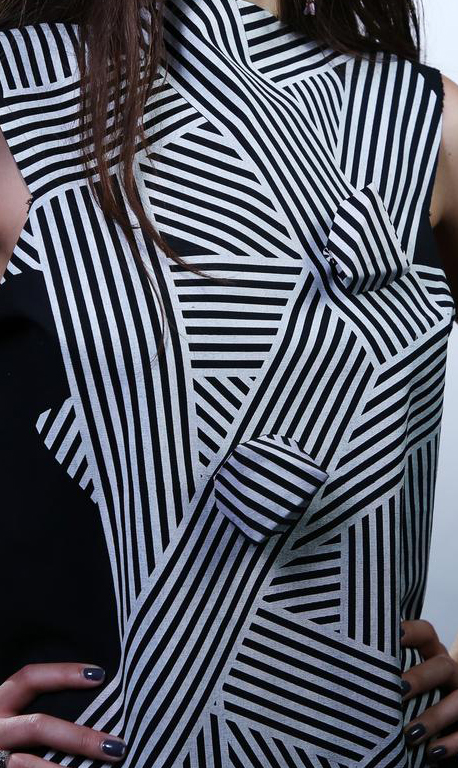
Kino
MIT Media Lab, Stanford University
This work explores a dynamic future where the accessories we wear are no longer static, but are instead mobile, living objects on the body. Engineered with the functionality of 18 robotics, this “living” jewelry roams on unmodified clothing, changing location and reconfiguring appearance according to social context and enabling multitude presentations of self. With the addition of sensor devices, they transition into active devices which can react to environmental conditions. They can also be paired with existing mobile devices to become personalized on-body assistants to help complete tasks. Attached to garments, they generate shape-changing clothing and kinetic pattern designs–creating a new, dynamic fashion.
It is our vision that in the future, these robots will be miniaturized to the extent that they can be seamlessly integrated into existing practices of body ornamentation. With the addition of kinetic capabilities, traditionally static jewelry and accessories will start displaying life-like qualities, learning, shifting, and reconfiguring to the needs and preferences of the wearer, also assisting in fluid presentation of self. We envision a new class of future wearables that possess hybrid qualities of the living and the crafted, creating a new on-body ecology for human-wearable symbiosis.

Heavy Duty Love
Lucy Mcrae
HEAVY DUTY LOVE
A cautionary narrative in an uncomfortable, complex debate on the scientific acceleration directing our evolutionary path —from gene-edited babies to CRISPR to AI — Heavy Duty Love is a mental health prop existent as a tactile mechanical structure, asking, “As we head toward a life designed from scratch, will we seek new types of intimacy?”. Realised as a speculative domestic device compensating for a lack of human touch in early life, Heavy Duty Love sandwiches the body between layers of soft, dampening materials normally used in contemporary camping or construction.
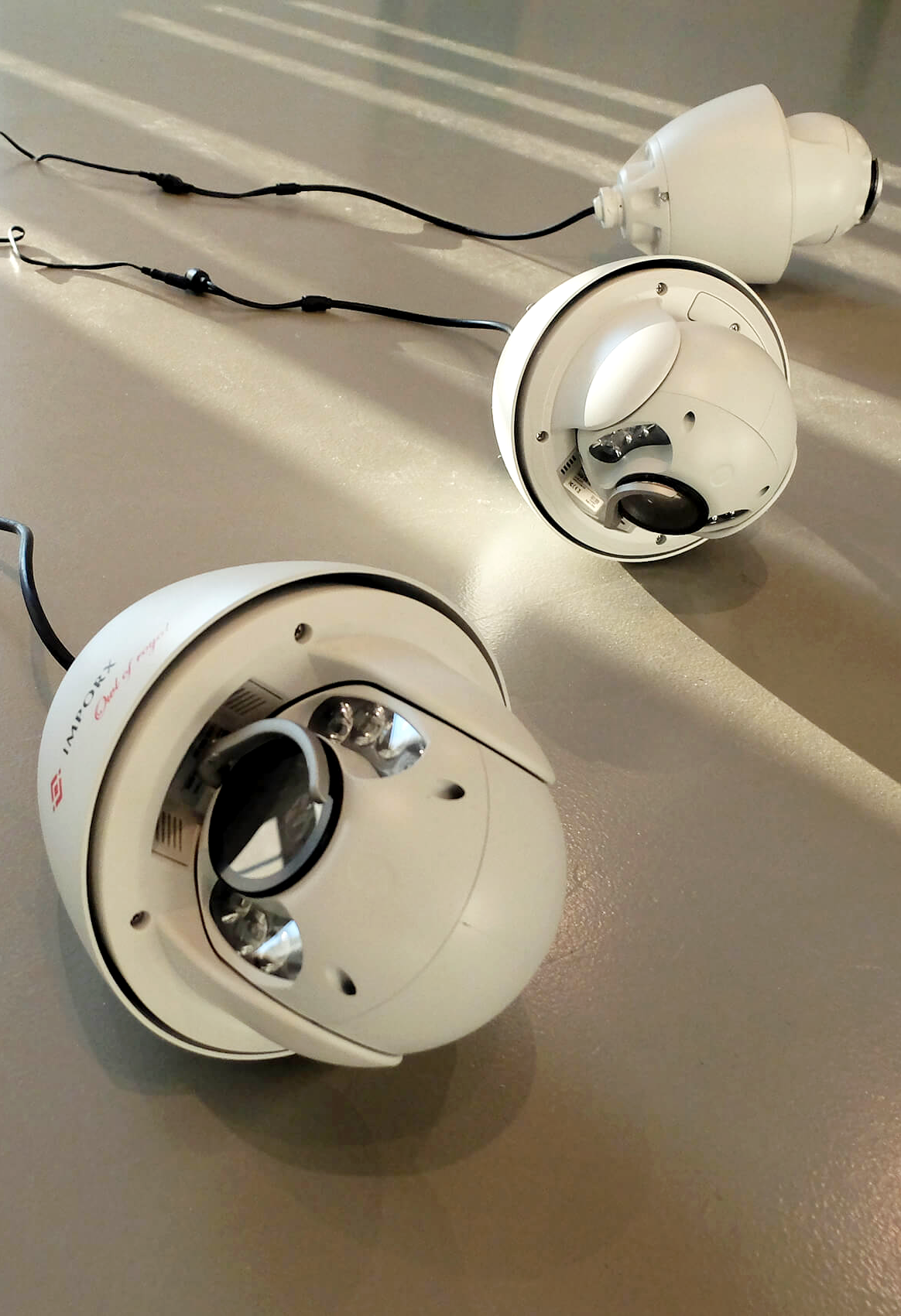
Aram Bartholl
Pan, Tilt and Zoom
Three motorized CCTV dome cameras are installed on the gallery floor. The built-in auto-tracking function makes the cameras follow any motion in the room. While moving its lens the center of the weight of the device shifts and the whole camera starts to roll on the floor. As a result the software is confronted with even more motion which needs to be tracked. From time to time the cameras bump into each other or start to follow and trigger each other movements.
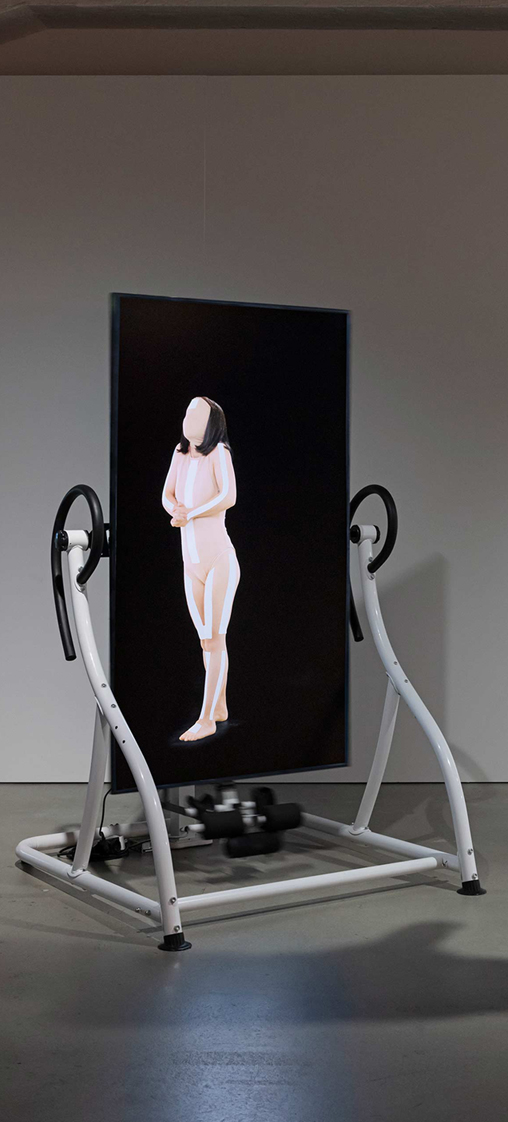
Coralie Vogelaar
infinite posture dataset
She moves by endlessly morphing to the rhythm of the device – strapped in the frame of the screen – following or giving instructions; part human, part machine. The design of the device is inspired by a gadget to cheat the step-counter on your smartphone. Technology tricked by technology. Her movements, caught within a motion capture like tight suit deconstructing her body parts, talk of complex and conflicting emotions, but her face, from which we usually read how someone is feeling, is hidden. But is the machine that is observing her deconstructed and re-sequenced postures actually capable of recognizing what the body is communicating? Are we?
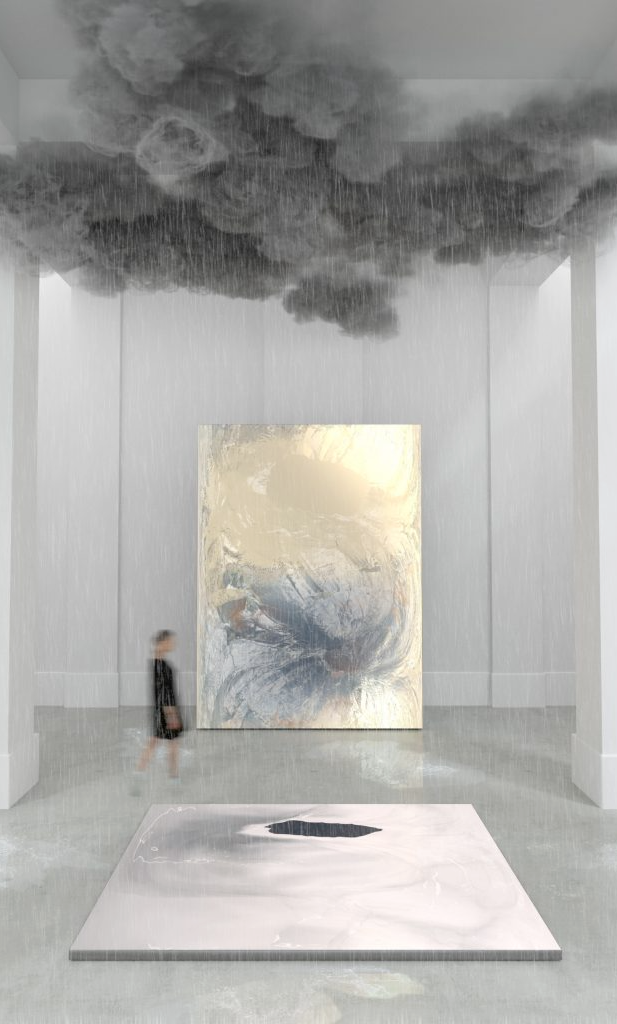
Carla Chan
Falling Black
Unfalling Black is an augmented reality experience that reveals digitally manipulated weather formation in an enclosed environment. Treating the mobile device as a digital window, the work uncovers the displacing choreography of rain, storms and snow, occurring all around the audience and yet witnessed only through the computerized lens.

OSKAR SCHLEMMER
أوسكار شليمر
奥斯卡·施莱默
אוסקר שלמר
オスカー·シュレンマー
오스카 슐 렘머
Оскар Шлеммер
Triadic Ballet
1-Margarete Hastings, Franz Schömbs, Georg Verden
1970
2-Super 16mm colour film, directed by Helmut Ammann.
Oskar Schlemmer saw the human body as a new artistic medium. He saw ballet and pantomimes as being free from the historical baggage of theater and opera and, therefore, capable of presenting his ideas of choreographed geometry, the man as a dancer, transformed by his costumes, moving in space. He saw the puppet and puppet movement as superior to that of the human, as this emphasized that the average of all art is artificial. This device could be expressed through stylized movements and the abstraction of the human body. Schlemmer saw the modern world being guided by two main currents, the mechanized (man as a machine and body as a mechanism) and the primordial impulse (the depths of creative urgency). He claimed that choreographed geometry offered a synthesis; the Dionysian and emotional origins of dance become rigid and Apollonian in its final form.
3-Bayerisches Junior Ballet München

DI MAINSTONE AND TIM MURRAY-BROWNE
Serendiptichord
The result of a cross-disciplinary investigation spanning fashion, technology, music and dance, the Serendiptichord is a wearable musical instrument that invites the user (or movician) to explore a soundscape through touch and movement. This curious device is housed in a bespoke box and viewed as part of a performance. Unpacked and explored on and around the body, the Serendiptichord only reveals its full potential through the intrepid curiosity of its wearer. Adhering to the body like an extended limb, this instrument is best described as choreophonic prosthetic. Referencing the architectural silhouette of a musical instrument and the soft fabrication of fashion and upholstery, it is designed to entice the movician to explore its surface through touch, physical manipulation and expressive movement. Although this acoustic device can be mastered alone, it also holds subtle openings for group interaction.
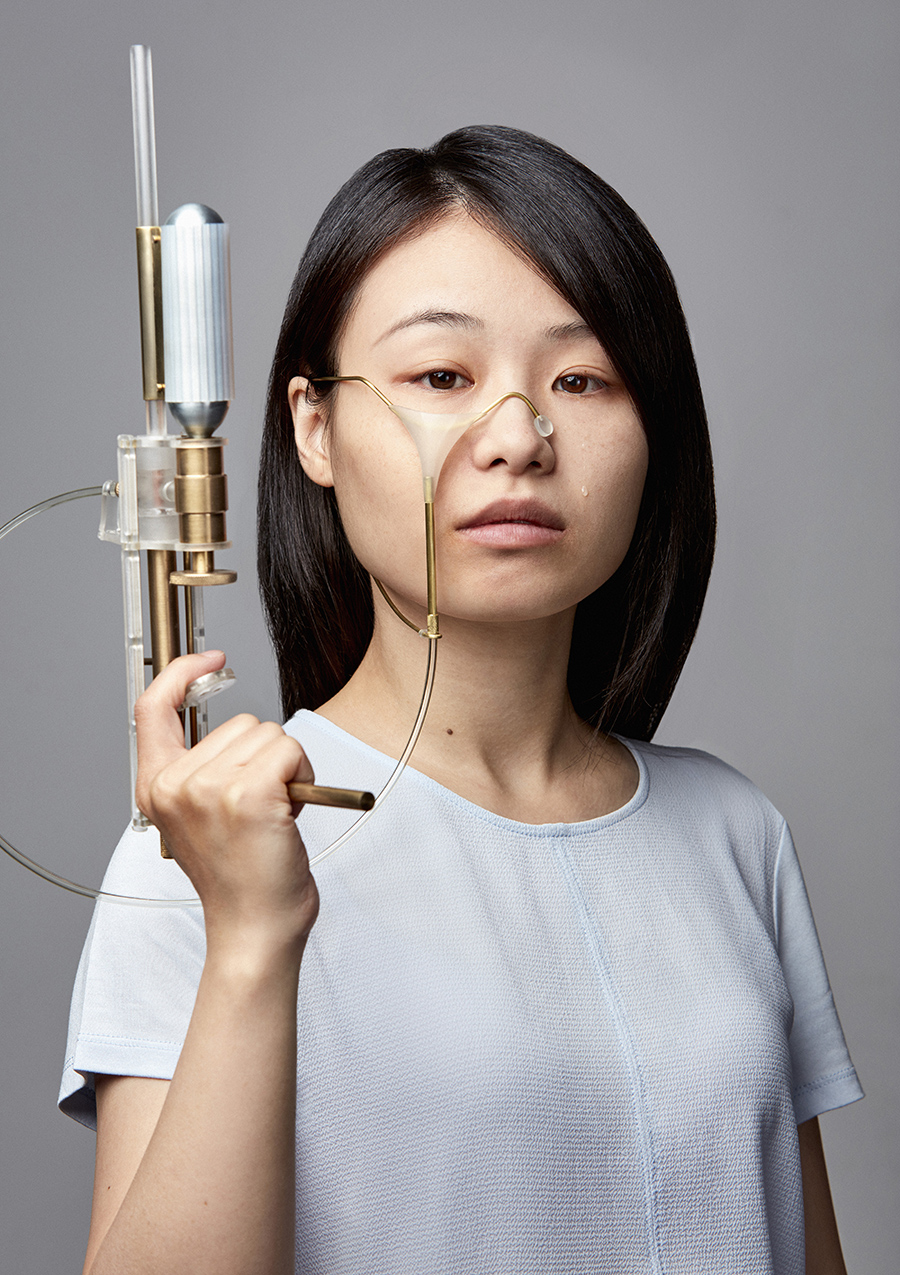
Yi-Fei Chen
Tear Gun
For Yi-Fei Chen, a graduate from Design Academy Eindhoven, her impossibility to speak up in self-defense during a confrontation with her tutors resulted in an internal burst of frustration, but externally only defenseless tears emerged. After that she decided to acknowledge this weakness, but reacting to it through her graduation project: “Tear Gun”, a minimal device that freezes tears instantly, ready to be fired in self-defense.
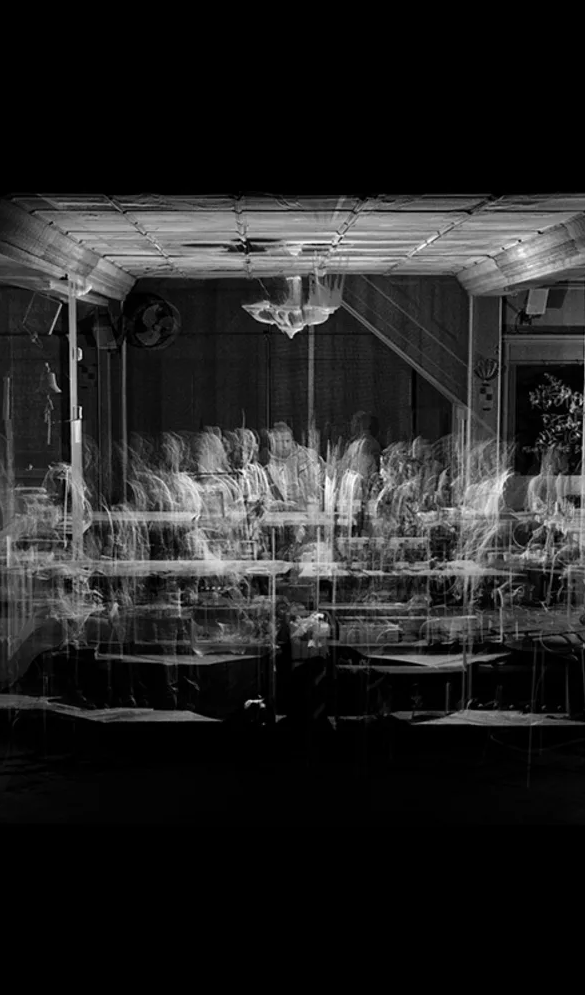
SCANLAB
FRAMERATE
Created from thousands of daily 3D time-lapse scans of British landscapes, the work observes change on a scale impossible to see with the lens of traditional cameras. This is not just an artwork. The data collected and presented by FRAMERATE is ground-breaking scientific research, containing empirical, measurable facts. We glimpse a future perpetually documented by the eyes of a billion autonomous vehicles and personal devices, creating high fidelity spatial records of the earth.

Lyota Yagi
Sound Sphere
An installation consisting of cassette tape wound around a spherical object and a device to play its sound. There is no beginning or end to the tape; rather, a small motor randomly moves the sphere as it sits atop the player, producing noise. The work varies in scale from installation to installation. Varying sizes of globes are covered with a length of time that is proportional to their surface area. When linear time is wound around a sphere, it is deprived of the relationship between place and time, and thus also loses its meaning (or in other words, causes meaning to arise).
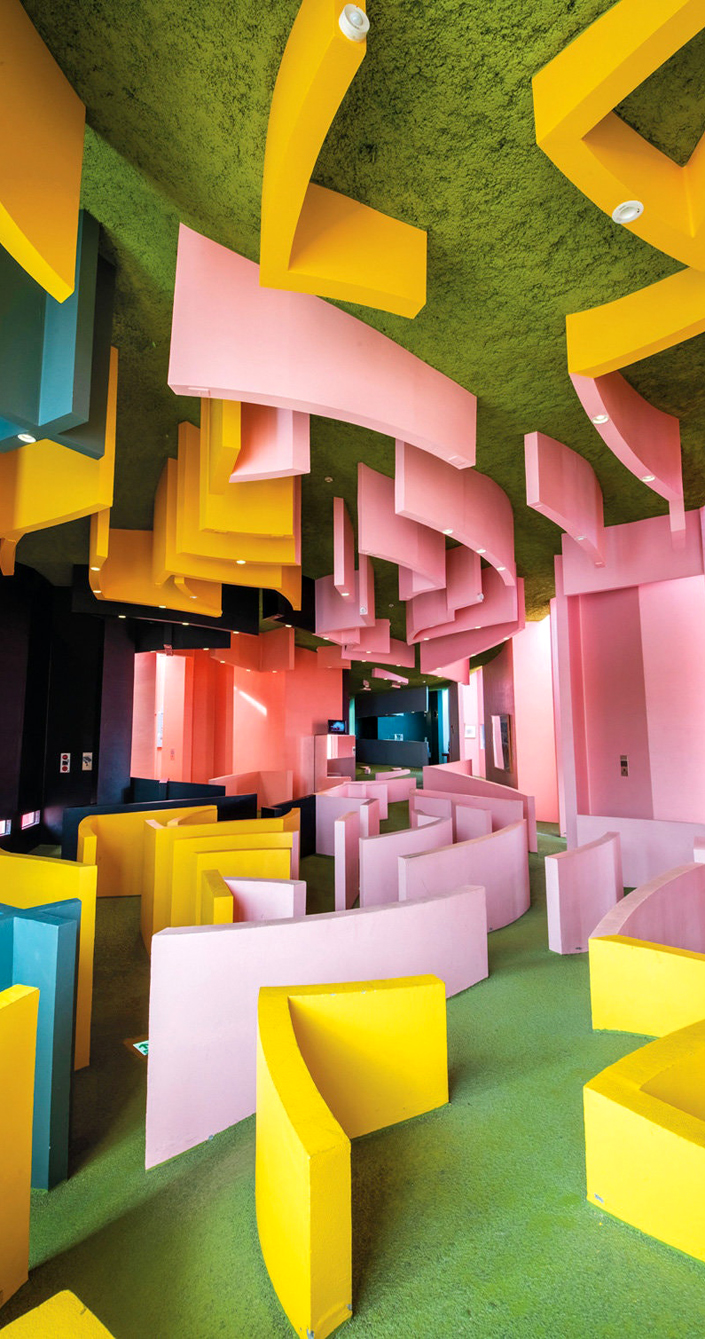
ARAKAWA + GINS
Yoro Park – Site of Reversible Destiny
“The couple first fully explored Reversible Destiny in what is regarded as their seminal gallery piece, “The Mechanism of Meaning,” an ever-evolving manifesto-cum-artwork begun in 1963, comprising 80 panels that they refined and added to over decades, many of them high-concept diagrams and puzzles with instructions and text (“A Mnemonic Device for Forgetting,” “Think One, Say Two”), made primarily of acrylic and mixed media on canvas. In an accompanying précis to the work, which was exhibited at the Guggenheim in 1997, they prescribed “no more irretrievable disappearances” and declared death “old-fashioned.” Critical opinion differs on how seriously the pair, whose work is in the collection of the Museum of Modern Art and Paris’s Centre Pompidou, took the grandiose quest to end death. But if it was intended as metaphor, neither of them ever let on. Indeed, though Arakawa himself died at 73, in 2010, and Gins four years later, at the age of 72, defying death became the defining work of their lives.”

Juuke Schoorl
Liquid Skin
‘Liquid Skin’ is a visual research towards the changing boundaries between the physical world of the human body and the digital world. By borrowing techniques found in touch screen technologies, but instead of following the cold underlying logic of present day devices, it proposes a situation where this border becomes liquid and sensual with an emphasis on the fluidity of touch and movement. Turning the skin itself into a medium of visual expression without the constraint of the technical grid.

ECAL
Automač
Fantastic Smartphones
Built around a simple mechanism, Tinder reduces the act of dating to a single swipe. This slide of the finger to the right or the left is enough to show our interest or disinterest in a profile that comes up. Although high-stakes, even when performed repeatedly, this movement can become purely mechanical and lose its meaning. As its name indicates, Automač is a device that enables us to automatically match with a maximum number of potential partners on Tinder. The automaton consists of a smartphone holder, a camera that observes the screen and a rotating mechanism to swipe on the smartphone screen. Via a screen interface, the user has the possibility to choose selection criteria. By automating this process and delegating it to a machine, Automač positions itself as an optimal machine to have a maximum amount of matches in a minimum amount of time.
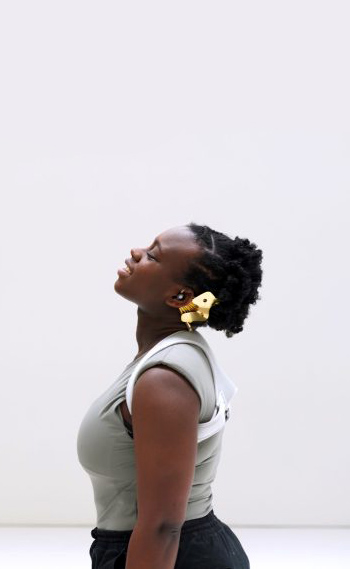
Abel Enklaar and Amy Johnson
MetaSensorium은 멀리 있는 사람들 사이에 새로운 수준의 연결을 생성하는 웨어러블 기술의 능력에 대해 추측함으로써 전염병에 만연한 사회적 고립에 대응합니다. 분리, 단절, 타인과 물리적으로 존재하고 싶은 욕망에 대한 디자이너들의 자전적 경험에서 출발한 MetaSensorium은 가상 수단을 통해 물리적, 감각적 연결을 구성할 수 있는 방법에 대한 질문에서 출발했습니다. 그 결과 웨어러블은 두 명의 착용자가 멀리서 서로를 마주할 때 활성화되어 그들의 장치가 스펙트럼 포용으로 상대방의 존재감을 전달하도록 트리거합니다.
.
MetaSensorium started with the question of how to build physical and sensory connections through virtual media. As a result, wearable is activated when two users face each other from a distance, triggering their devices to convey each other’s presence with spectral inclusion.

Julian Scordato
Constellations
File Festival
FILE HIPERSONICA
This work begins from the exploration of an imaginary celestial space which is translated into sound space. How does each celestial sphere – starting from its manifestation as a unit – interact with the cosmos where it belongs? How does it react to its law? How does it transform itself integrating with the system, until the loss of identity? In contrast to this process, the constellations act by highlighting the bodies in their uniqueness through the creation of symbolic links: beyond their meaning, they stand as a classification and articulation device of the individual within the system.
.
Questo lavoro parte dall’esplorazione di uno spazio celeste immaginario che si traduce in spazio sonoro. In che modo ogni sfera celeste – a partire dalla sua manifestazione come unità – interagisce con il cosmo a cui appartiene? Come reagisce alla sua legge? Come si trasforma integrandosi con il sistema, fino alla perdita di identità? In contrasto con questo processo, le costellazioni agiscono mettendo in evidenza i corpi nella loro unicità attraverso la creazione di collegamenti simbolici: al di là del loro significato, si pongono come dispositivo di classificazione e articolazione dell’individuo all’interno del sistema.

ALEXANDER PONOMAREV
База
Объект «База» реализован во время работы художника по приглашению Министерства культуры Франции в ателье Кольдера в городе Саше. Девятиметровая горизонтальная труба, заполненная водой, образует тоннель для движения черной подводной лодки, которая, двигаясь по принципу троллейбуса, улавливается в крайних точках специальным устройством. Приподнимаясь над водой, на пропеллерах лодка поворачивается в обратную сторону и подобно хамелеону изменяет свою окраску, превращаясь в разноцветную и красивую. После погружения в воду лодка опять чернеет и стремительно продолжает движение
.
Base
Object “Base” was realized during the artist’s work at the invitation of the Ministry of Culture of France in the atelier Colder in the city of Sachet. A nine-meter horizontal pipe, filled with water, forms a tunnel for the movement of a black submarine, which, moving according to the principle of a trolleybus, is caught at the extreme points by a special device. Rising above the water, on the propellers, the boat turns in the opposite direction and, like a chameleon, changes its color, turning into a multi-colored and beautiful one. After immersion in the water, the boat turns black again and continues to move rapidly

ANDY LOMAS
Morphogenetic Creations
Created by a mathematician, digital artist and Emmy award winning supervisor of computer generated effects – Andy Lomas, Morphogenetic Creations is a collection of works that explore the nature of complex forms that can be produced by digital simulation of growth systems. These pieces start with a simple initial form which is incrementally developed over time by adding iterative layers of complexity to the structure.The aim is to create structures emergently: exploring generic similarities between many different forms in nature rather than recreating any particular organism. In the process he is exploring universal archetypal forms that can come from growth processes rather than top-down externally engineered design.Programmed using C++ with CUDA, the series use a system of growth by deposition: small particles of matter are repeatedly deposited onto a growing structure to build incrementally over time. Rules are used to determine how new particles are created, and how they move before being deposited. Small changes to these rules can have dramatic effects on the final structure, in effect changing the environment in which the form is grown. To create these works, Andy uses the GPU as a compute device rather than as a display device. All the data is held in memory on the GPU and various kernel functions are called to do things like apply forces to the cells, make cells split, and to render the cells using ray-tracing. The simulations and rendering for each of the different animated structures within this piece take about 12 hours to run, Andy explains. By the end of the simulations there are over 50,000,000 cells in each structure.The Cellular Forms use a more biological model, representing a simplified system of cellular growth. Structures are created out of interconnected cells, with rules for the forces between cells, as well as rules for how cells accumulate internal nutrients. When the nutrient level in a cell exceeds a given threshold the cell splits into two, with both the parent and daughter cells reconnecting to their immediate neighbours. Many different complex organic structures are seen to arise from subtle variations on these rules, creating forms with strong reminiscences of plants, corals, internal organs and micro-organisms.

Michele Spanghero
Dià
Dià (from greek διά, through) is a sculpture installed on a piece of no man’s land on the top of mount Pal Piccolo on the border between Italy and Austria, where World War I was fought. The double-trumpet shaped sculpture symbolically connects, both visually and acoustically, the first lines’ trenches. Two arched doors, that refer to the entrance of the shelters and trenches, turn into cavities to listen or observe the surrounding landscape. The work, conceived as a symbolic link between the two fronts, combines the dimensions of silence and sound: dià is indeed a device that invites audience to interact with the two cavities as a megaphone or a peephole, to start an intimate dialogue through the sculpture.

Whyixd
Through the Membrane
We define the space around us by observing and perceiving light and shadow. That is to say, our perception shapes our basic understanding of this sensory world, and hence the “reality” we believe in. If our experiential knowledge and awareness of space are challenged, would our definition of a “real phenomenon” also be changed? Through the Membrane utilizes optical polarizers to change how light passes through space. The installation does not rely on any electromechanical devices. Simply with creative use of material and structure, it presents a super-sensory experience in space where reality and illusion are inextricably juxtaposed.

Kasuga
DMX Linear Actuator Slim
The motion study with the DMX Linear Actuator Slim demonstrates a synchronized kinetic sculpture with 25 components (vertical and horizontal mount) and a sphere fixture (black and white). Controlled by the DMX LA Designer software, multiple motion sequences, pattern generators and text and image contents are transferred onto the array. Furthermore, interaction with the kinetic sculpture is made possible via the Leap Motion Sensor, the Kinect Sensor and other mobile devices via the OSC protocol.
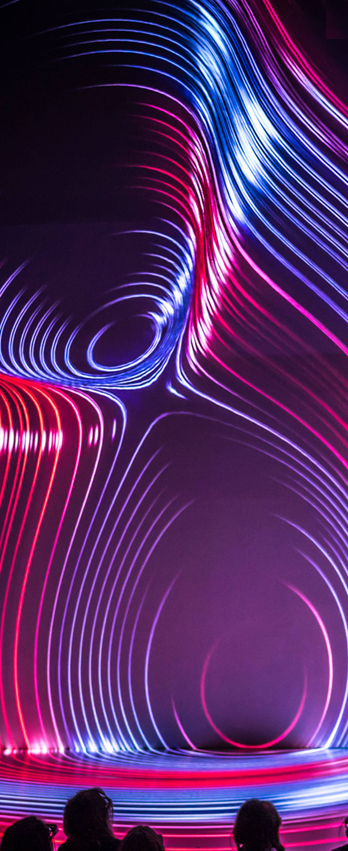
nohlab
prima materia
Prima materia, as the first element, the ubiquitous starting material required for the alchemical processes, reveal transformation of our times.The matter of all forms create various transmutations, attached to laboratory processes, form and color changes in 3D, used as a model for the individuation process, and as a device in art and technology.That pure matter, existing in nature, is converted to other imperfect bodies that it interacts with, and this way is rediscovered and brought to the front by art and technology.
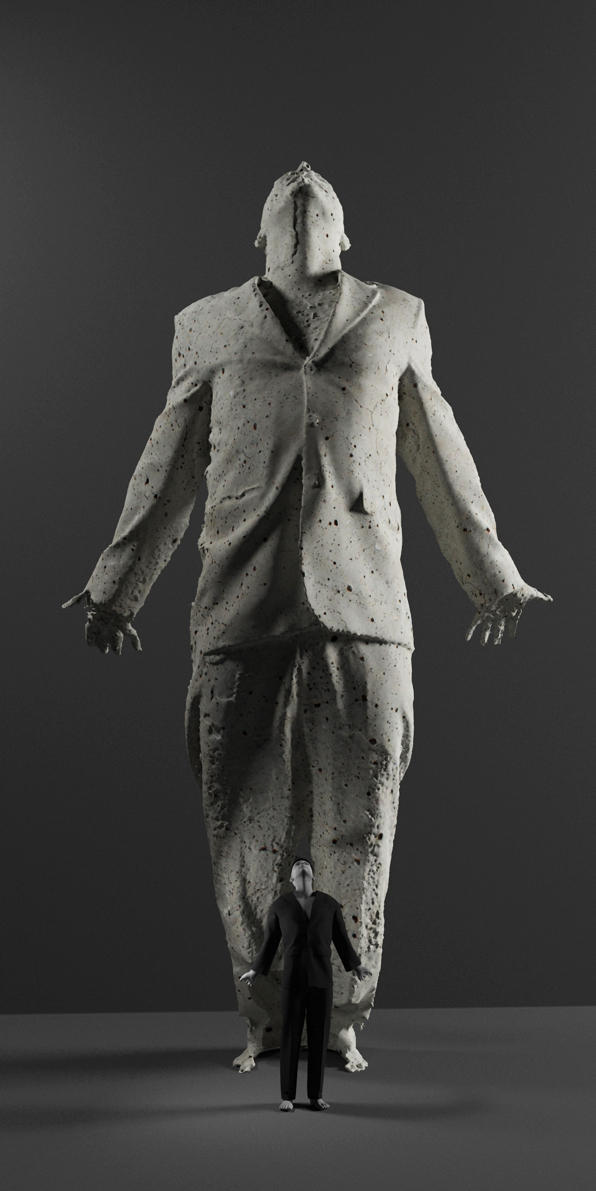
Leonhard Lass & Gregor Ladenhauf
The Eidolon Splits
The Eidolon Splits explores the construction of human form and identity within a narrative realm. It reflects and embodies the screen as a portal and contact surface both as a physical and a virtual device.

Patricia Olynyk
Oculus
Oculus is a large-scale, collaborative light sculpture that depicts a colossal abstracted drosophila eye, replete with compound faceted surfaces. It both recalls the circular opening at the apex of a cupola and alludes to a surveillance device or drone hovering in mid-air. Oculus is inspired in part by a series of scanning electron micrographs produced in a transgenic lab while researching human and non-human sensoria. The work evokes affective encounters with scale such as viewing miniature particles through the lens of a microscope or wandering through monumental physical environments. As each viewer’s reflection plays across the sculpture’s undulating surface, the apprehension of the self affects both individual and collective behavior in unexpected ways. This affective dynamic plays on the precariousness of our coexistence with other lifeforms in the world, one that is always contingent upon viewers’ bodies and the variability of the environment around them. The act of gazing at Oculus also puts into play the reciprocal condition of both seeing and being seen.

Joanie Lemercier
Brume
Brume is a series of works and installations by Joanie Lemercier, using a custom made device made of atomized water. Joanie frees his work from the screen and usual physical devices. He is using space and immateriality as a canvas, creating a mid air floating projection feeling. Thanks to this volumetric tool, he is modifying our frontal relationship with screen and allowing new interaction between the viewer and the projected image. Joanie Lemercier is still exploring the possibilities of this new medium with a series of experiences and chapters, questioning our view of reality. In his work, Joanie is researching timeless subjects like light, matter, geometry. With Brume, he is also interested in the link between water and light.

ADRIEN M / CLAIRE B
The Movement of Air
A frontal show for three dancers evolving in an immersive environment made up of images projected, generated and animated live. A show where two impossible ones come together: the body that flies, thanks to suspension devices and the body that fits into the image. An acrobatic and digital choreographic writing which outlines a body language opening onto other relationships to time, space and the world. Beyond the search for technical prowess, it is that of a dreamlike movement and writing through images.

sarah oppenheimer
N-01
The artist creates an unprecedented visuospatial system that transforms the historical museum and its viewers alike.Visitors are kindly invited to touch and move the black metal and glass elements of the artwork.The built environment is inhabited through an array of inputs and outputs. Our bodies set in motion invisible chains of cause and effect. Enter a room: lights turn on. Turn a handle:a door opens. This relay is modulated through system controllers, devices programmed to respond to moving bodies and aural commands. Buried within walls, floors and ceilings, building networks are a black box.

Ani Liu
Eyeris
Eyeris is a cultural prosthetic that renders the user dependent on human touch for sight. While many of today’s digital devices extend our abilities to connect with each other, disability of our current digital devices can been seen through our loss of tangible human interaction. I made this piece in trying to explore the importance of human interdependency in a society living under the myth of autonomy driven by technological symbiosis between man and computer. Eyeris is a mechanically operated electronic device powered by digital input that is deliberately over-engineered to call attention to the social behavioral conditioning imposed on us through less discreet technological devices that we assimilate on a daily basis.

REVITAL COHEN & TUUR VAN BALEN
The Immortal
A number of life-support machines are connected to each other, circulating liquids and air in attempt to mimic a biological structure.
The Immortal investigates human dependence on electronics, the desire to make machines replicate organisms and our perception of anatomy as reflected by biomedical engineering.
A web of tubes and electric cords are interwoven in closed circuits through a Heart-Lung Machine, Dialysis Machine, an Infant Incubator, a Mechanical Ventilator and an Intraoperative Cell Salvage Machine. The organ replacement machines operate in orchestrated loops, keeping each other alive through circulation of electrical impulses, oxygen and artificial blood.
Salted water acts as blood replacement: throughout the artificial circulatory system minerals are added and filtered out again, the blood gets oxygenated via contact with the oxygen cycle, and an ECG device monitors the system’s heartbeat. As the fluid pumps around the room in a meditative pulse, the sound of mechanical breath and slow humming of motors resonates in the body through a comforting yet disquieting soundscape.Life support machines are extraordinary devices; computers designed to activate our bodies when anatomy fails, hidden away in hospital wards. Although they are designed as the ultimate utilitarian appliances, they are extremely meaningful and carry a complex social, cultural and ethical subtext. While life prolonging technologies are invented as emergency measures to combat or delay death, my interest lies in considering these devices as a human enhancement strategy.This work is a continuation of my investigation of the patient as a cyborg, questioning the relationship between medicine and techno- fantasies about mechanical bodies, hyper abilities and posthumanism.

COOP HIMMELB(L)AU
CHBL Jammer Coat
The CHBL Jammer Coat is a piece of clothing that enables its user to disappear: Google cannot find you anymore. The piece is made of metallized fabrics, which are blocking radio waves and shielding the wearer against tracking devices. You are no longer reachable on your mobile phone and no information from your credit card can be captured. The Wave Circle pattern of the fabric gives an illusion of strange multiple body parts, which hides and frees the individual physicality.

Harrison Pearce
Defence Cascade
In the installation inflated silicone forms are suspended amidst an austere metal structure, and are prodded by automated rods. Set to contrastingly beautiful music by composer Alex Mills, which is punctuated by the industrial sounds of the mechanised device, the art work looks like a science experiment, or some kind of torture device, and you may find yourself anthropomorphising the poor, inflated bags which are at the mercy of their mechanical environment.

Richi Owaki
The Other in You
The Other in You, developed as a new way to experience dance, has realized a novel dance audience experience. We assembled the cutting-edge Computer Graphics, haptic feedback device which directly express the dance to the body, 16 stereophony channels sound and research on Virtual Reality techniques to realize this work. How can we relate to others, who are supposed to be distant from us? Do we really know what it is to “see”? The Other in You is an attempt to revive the notion of our body in relation to an object, a notion, which had been forgotten in the act of watching. Virtual reality technology enables us to bring the act of watching, once detached from the body, back to where it belongs. And as a result, it reconstructs the notion of “seeing“.

Christina Kubisch
Cloud
Cloud, produced on-site at the museum using thousands of feet of red electrical wire, hosts a fourteen-channel composition that visitors listen to by wearing customized headphones. These devices, developed by the artist, contain magnetic coils that receive the magnetic fields circulating in the cable loops and make them audible. As visitors move around the installation, they look at the chaotic electrical wiring suspended in the gallery but hear the prerecorded sounds programmed into different segments of the sculpture.

Moritz Simon Geist
Soft Manipulator
A playful interactive installation where the audience experiments with rhythms, mechanics and objects. Everyday items like glasses, pots, as well as small music instruments are placed on a light plattform. Seven robotic mechanic devices can be manipulated interactively by the audience, manipulating the sound of the objects. The six robotic mechanics beat the objects, creating a constantly changing polyrhytmic web of sound and rhythm.

Kouichi Okamoto
Re Rain
“Re-rain” is a sound installation expressing non-visible elements such as gravity, magnetic force, and sound as physical elements. This installation is created with the sound of rain sampled in Japan early spring of 2016.The sound of raindrops hitting an umbrella are recorded, and is then played back from a speaker. The umbrella is set on top of a speaker, and the vibration of the speaker is transmitted through the umbrella to make a sound. For example, an umbrella cannot vibrate if the magnetic force of the speaker is small or if the rain hitting the umbrella is either too high or too low in pitch extent. For this reason, this is a device picking out a state in which the magnetic force of the speaker, weight of the umbrella, and pitch extent of sound are all in a balanced state. Natural phenomena such as rain travels through an object and is emitted as sound to the air..

JOSCHI HERCZEG AND DANIELE KAEHR
LAMP
Joschi Herczeg and Daniele Kaehr, originally from Switzerland, surprise the world of photography by capturing movement for the fraction of a second that makes up an explosion.To do this, the two friends used very specific pyrotechnic systems and have even create a custom detonator device, connected and synchronized directly to their camera.

Lauren Lee McCarthy
SOMEONE
SOMEONE imagines a human version of Amazon Alexa, a smart home intelligence for people in their own homes. For a two month period in 2019, four participants’ homes around the United States were installed with custom-designed smart devices, including cameras, microphones, lights, and other appliances. 205 Hudson Gallery in NYC housed a command center where visitors could peek into the four homes via laptops, watch over them, and remotely control their networked devices. Visitors would hear smart home occupants call out for “Someone”—prompting the visitors to step in as their home automation assistant and respond to their needs. This video installation presents documentation from the initial performance on four screens throughout the space.

BR41N.IO
Mindscapes
The BR41N.IO Hackathon brings together engineers, programmers, physicians, designers, artists or fashionistas, to collaborate intensively as an interdisciplinary team. They plan and produce their own fully functional EEG-based Brain-Computer Interface headpiece to control a drone, a Sphero or e-puck robot or an orthosis with motor imagery. Whenever they think of a right arm movement, their device performs a defined action. The artists among the hackers make artful paintings or post and tweet a status update. And hackers who are enthusiasts in tailoring or 3D printing give their BCI headpiece an artful and unique design. And finally, kids create their very own ideas of an interactive head accessory that is inspired by animals, mythical creatures or their fantasy.

Dragan Ilic
A3 K3
A3 K3 is a unique interactive experience. Artworks are created by machine technology and audience participation. Dragan Ilić uses g.tec’s brain-computer interface (BCI) system where he controls a hi-tech robot with his brain. The artist and the audience draw and paint on a vertical and a horizontal canvas with the assistance of the robot. The robotic arm is fitted with DI drawing devices that clamp, hold and manipulate various artistic media. They can then create attractive, large-format artworks. Ilić thus provides a context in which people will be able to enhance and augment their abilities in making art.

Assocreation
Solar Pink Pong
file festival
Solar Pink Pong” is a hybrid of street and video game. Players of this game can interact with an animated pink sunlight reflection on the street using their bodies and shadows. The device that makes this game possible can be mounted on utility poles or building sides.

DOMINIC WILCOX
دومينيك ويلكوكس
多米尼克·威尔科克斯
דומיניק וילקוקס
ドミニク·ウィルコックス
Доминик Уилкокс
I designed this product in an attempt to give those people a new, more acceptable alternative. I hope that this device will lower the bar for initiating reconciliation from the heights of the full contact hand on hand handshake to a more palatable non contact handshake. I plan to contact embassies around the world where resentment is prevalent. I would like to see all family counseling offices have one in their meeting rooms. I would encourage anyone who has fallen out with a friend, family member, work colleague, gang member or world leader to use the Pre-handshake Handshake Device and let bygones be bygones.

JORG NIEHAGE
Samplingplong
File Festival
Randomly selected, acoustically usable finds (electronic junk, relays, plastic toys,compressed air valves, pneumatically operated components) are combined with cables and tubes. Via a device controlled by computer, they are turned into interactive instruments. An improvised ensemble evolves, from which – per mouse-over and mouse-click -short miniature compositions of dense rhythmic clicks, hisses, whirs, hums and crackles can be elicited. A tapestry of sound bursts forth from the floral-like web of cables and tubes. The installation can be used by the projected mouse-cursor: rolling over the improvised instruments causes small sound events. Activating the installation by rolling over its parts enables the user to play spontaneous improvisations. Clicking these objects starts short programs of loop-like compositions. Small “techno-compositions en miniature”, rhythmic patterns of analog (or real) sounds; a physical low-tech simulation of electronic, digital music, perhaps an ironic comment on interactivity.

Antoni Rayzhekov
10VE:SEQUENCE FOR TWO
10VE:SEQUENCE FOR TWO is a duet for two amplified bodies equipped with wireless biofeedback and movement devices, measuring the performers heart-rate, stress-level, breath and movement. The synchronizations and correlations of the signals generate a musical representation of the occurring processes between their bodies.
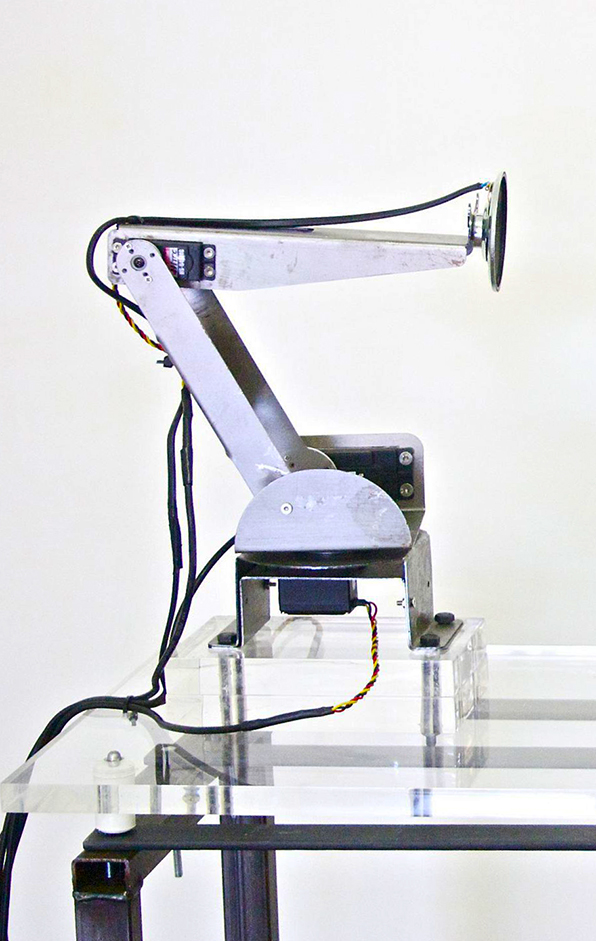
Roberto Pugliese
Equilibrium Variant
This work has the purpose of exploring the occurrence of the Larsen effect (also known as feedback) through the use of mobile devices in a three-dimensional space. The distinctive screech of the Larsen effect typically occurs when a microphone catches the sound emitted by a speaker. It engages when the microphone is located too close to the speaker, and gets in the way of its frequency. The microphone amplifies and reproduces the speaker’s frequency with an ever-increasing width, virtually unlimited, in practice stopped by the amplifier’s clip. On a ground support, two mechanical arms are located. At the end of one arm there is a microphone, and on the end of the other there is a speaker. A software, created with this specific purpose, manages the position of the arms in a dynamic way, and provides that the distance between the microphone and the speaker never causes the amplifier to clip. This way, the system tends to reach an equilibrium that is physically impossible to attain. The struggle to balance creates an acoustic and visual dimension that is never the same: the frequency of feedback and the movements of the mechanical arms are always different and change in real time.

Rasa Smite & Raitis Smits
Swamp Radio
Swamp Radio gets beyond our anthropocenic reality, and maintains connections between the humans and other species. By artistic interventions and transmitting interfaces, the Swamp Radio is turned into a social media megaphone for invisible and inaudible actors of nature. The artists are installing microbial fuel cells, environmental monitoring sensors and transmitting devices to transform the swamps into dynamic power plants and the 21st century multi-voiced broadcast media.

